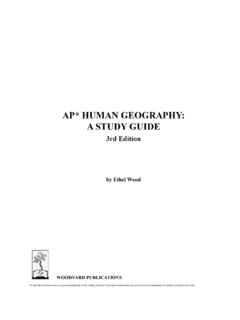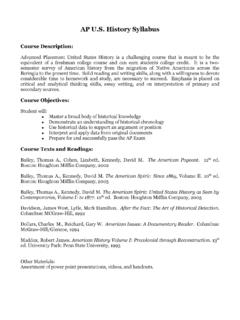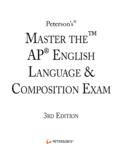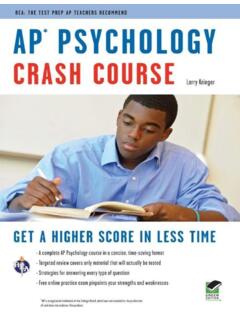Transcription of AP Human Geography Unit 2b: Migration Guided …
1 AP Human Geography Unit 2b: Migration Guided Reading/ study guide Mr. Stepek Rubenstein p 78 85 (Introduction/Why Do People Migrate?) We will discuss this in class. The terms used in the two textbooks relating to the types of movement which are less than permanent are often confusing and contradictory. Description Rubenstein de Blij All movement mobility Non-permanent movement Shorter periods away from home: called what? circulation cyclic movement creates what?: activity space Longer periods away from home: college, nomadism seasonal mobility periodic military service, migrant labor, transhumance periodic snowbirds cyclic ?
2 1. Permanent movement to a new location is called _____. a. Term for the Migration FROM a place _____. b. Term for the Migration TO a place _____. c. The difference between the number of immigrants and emigrants _____. d. If the # of immigrants exceeds the # of emigrants the location has _____. e. If the # of emigrants exceeds the # of immigrants the location has _____. 2. Into what three thematic groups can Ravenstein s Migration laws be organized. a. _____. b. _____. c. _____. 3. REASONS: Of the three factors in the chart below, why do most people migrate?
3 _____. 4. Define push/pull factors and give examples of each for the above three categories. Factor Push Pull Definition: Definition: Examples Economic Cultural What is a refugee? Environmental What physical factor is the biggest reason for environmental Migration ? 5. What are intervening obstacles/opportunities _____ _____ a. Historically intervening obstacles have been what? _____ b. In modern times, intervening obstacles tend to come in what form? _____ _____ c. What do we call a Migration pattern that is interrupted into a series of stages rather than a long unbroken route (it has been interrupted by intervening obstacles/opportunities)?
4 (de Blij p 89) _____ 6. DISTANCE: What are the two Ravenstein Laws of Migration relating to the distance of Migration ? a. _____ b. _____ 7. Complete the following chart, defining and categorizing the different types of Migration distances: Type Definition Subtype Definition/Examples Internal International 8. On your demographic transition chart, fill in the row labeled Zelinsky s Migration Transition and describe the typical Migration pattern found in each of the first four stages based on the information found on page 84. 9. CHARACTERISTICS: What are the two main patterns (a & b below) that Ravenstein found in the traits of migrants.
5 A. _____ Why? _____ _____ How is this supported by historical Migration patterns to the _____ _____ How has this changed in recent years? _____ _____ b. _____ How is this supported by immigrant demographics? _____ _____ How is this supported by statistics on what immigrants are NOT? _____ _____ Rubenstein p 85 92 (Key Issue 2: Where are Migrants Distributed?) 10. What % of global population are international migrants? _____ 11. According to figure 3-5 on page 84 of Rubenstein: Three largest migrant flows: Therefore, most Migration flow is from what countries of what level of development to what level of development?
6 _____ to _____ to to to 12. US IMMIGRATION PATTERNS (information on p 86 88 but we will fill this chart out together, leave for lecture) Era Source of immigration (or lack thereof) Why? (push-pull factors) Where did they settle? Colonial to Early thru early 1800s 19th century through the early 20th century 1840s - 1850s 1870s-1880s Pre-WWI (1900 1914) 1920s Discuss rules and impact of 1920s quota laws (p 92) 1930/40s Late 20th century current Post WWII (with most changes after 1970) What led to the change in immigration quota laws in the mid-1960s?
7 _____ What are the priorities set by the US government for granting entrance visas? 1. _____ 2. _____ 3. _____ Define brain drain: Unauthorized immigration (p 90). How many are estimated? Largest source/%? What type of work do they perform? Rubenstein p 88 90 (Impact of Immigration on the ) 13. How has Europe s status with regard to the demographic transition affected immigration to the both historically and currently?_____ _____ _____ 14. What affect did European Migration have on the and other destination areas? _____ _____ _____ 15. What is chain Migration _____ _____ Rubenstein p 92 93 (Temporary Migration for Work) 16.
8 What are guest workers? _____ _____ a. Where is the use of guest workers especially prevalent? _____ b. What role do guest workers fulfill for their host countries? _____ _____ c. How does the home country s economy benefit from guest worker programs? _____ _____ _____ d. What are the payments sent to the home country called? (de Blij p 79) _____ Rubenstein p 94 95 (Cultural Challenges Faced While Living in Other Countries) (please read, we will discuss in class!) Rubenstein p 95 97, 99 100 (Key Issue #4: Why do People Migrate Within a Country?) 17. Trace the settlement/internal Migration patterns found throughout the history of the US Era Description of Migration /settlement, time period and push-pull factors motivating it Colonial Settlement Early Settlement of the Interior Migration to California Settlement of the Great Plains Urbanization (p 99) Great Migration (lecture) Suburbanization (p.)
9 99) What is counterurbanization? Recent Growth of the South Read pages 97 98 about interregional Migration in other countries. de Blij (Ch 3 Migration ) As you read Chapter 3 in de Blij, you will note that much of the information is redundant (repeats) information you detailed or summarized above. You should add detail provided by de Blij to charts above where appropriate (for example, you should definitely note under the chart for #7, that the Atlantic Slave trade is history s worst example of a forced international Migration .) Please read the chapter in its entirety and complete the following items for information not covered by Rubenstein.
10 18. What is the gravity model? _____ _____ _____ 19. Discuss the following push/pull factors: Factor Description (including significant examples) Legal Status Power Relationships Political circumstances Armed Conflict and Civil War Environmental Conditions Culture and Traditions Technological Advances What phenomenon is caused by kinship links and chain Migration ? Economic Opportunities Reconnection of Cultural Groups Conflict and War 20. GLOBAL Migration PATTERNS. Based on the map/figure on p 94 95 in de Blij and the related text. Identify the major routes of Human Migration between 1500 and 1950.








